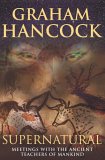![]()
![]()
SUPERNATURAL:
Meetings with the Ancient Teachers of Mankind
GRAHAM HANCOCK

A Book Review by Andrew Collins
I have just finished
reading Graham Hancock's
new book SUPERNATURAL
(Century, 2005), and can honestly say that it is one of the best books
I have ever read. He opens the book by doing massive amounts of ayahuasca
with native peoples of the Upper Amazon, and iboga, or ebogaine, the
wonder drug of Gambia, under medical supervision in Bath, before exploring
the explosive theory put forward by David Lewis-Williams in 1988 that
much, if not all of the Upper Palaeolithic cave art in South-west Europe,
as well as the San art of South Africa, is the result of shamanic journeying.
In Europe it was most likely a species of psilocybin mushroom, such
as the common Liberty Cap, that shamans used to achieve a trance, while
in Africa it was the more natural use of trance dancing.
Having established the reality of this theory, Hancock goes on to advance
the notion that what shamans, or anyone else for that matter, see whilst
in an induced trance state could well be glimpses of a very real human-less
parallel existence, accessible to us only during altered states of consciousness,
whether induced or purely spontaneous. He examines the evidence for
medieval and more recent fairy lore being an extension of this paradigm,
and compares these experiences with abduction phenomena, which he does
view in terms of the ET hypothesis. All these highly controversial areas
of study nicely dovetail in a way that becomes almost disconcerting
to read, especially when he gets on to the bizarre evidence of abductees
creating hybrid babies that remain in the alternative realms.
Yet then he looks at the work of Dr Rick Strassman, author of DMT: THE SPIRIT MOLECULE (2001), which is a scholarly work examining the effects of controlled DMT experiments using hundreds of test subjects. A great many report very similar hallucinations that have striking parallels with alien abductions and fairy lore. Indeed, Strassman himself came to the conclusion that what the subjects experience might well result from interaction with a human-less reality.
Hancock also covers a lot of ground which will feature also in my upcoming
book, especially the work of Jeremy Narby, author of THE COSMIC SERPENT:
DNA AND THE ORIGINS OF KNOWLEDGE (1995) who, following his own ayahausca
experiences with native peoples in the Upper Amazon, came to the stunning
conclusion that since all life breaks down into the same molecule, i.e.
DNA, interactions take place on a sub-atomic level between our DNA and
that of the rest of the plant and animal kingdom. It was an idea he
used to explain why the indigenous peoples of the Upper Amazon related
how their vast knowledge of the plant world, involving tens of thousands
of species, was obtained by shamans from the spirit world during ayahuasca
sessions. Remember, the principal active ingredient of ayahuasca is
DMT.
Graham Hancock's
SUPERNATURAL touches on the story of Francis Crick, the Cambridge astrobiologist
who cracked the DNA code in the 1950s. Something he points out, and
I will take further, is that in 2004, following his death at the age
of 84, it was revealed that he had regularly used LSD in his younger
days (then still legal in this country),and that it was whilst on a
trip that the structure of the DNA molecule was revealed to him. Strange
then that Crick, as Hancock's points out (and I will do too), went on
to champion the concept of Panspermia, the possibility that the building
blocks of life came originally from deep space. Did this view of life
also derive from his drug experiences? The concept of panspermia was
also given full support by the leading astronomer and rebel astrophysicist
Sir Frederick Hoyle before his death at the age of 86 in 2001.
Starting off a book by taking drugs might seem like literary suicide,
and let's face the scholarly community are going to have a field day
with SUPERNATURAL. However, taking the bull by the horns was probably
the right decision for Hancock to have made, for he certainly shows
the relevance of his own experiences. Moreover, you just know that in
the true Terence McKenna style (see his brilliant INVISIBLE LANDSCAPES),
that if you do do hallucinogens then you are going to see the world
in a completely different light, and come up new ideas that are rarely
available to you under usual circumstances.
I thoroughly recommend SUPERNATURAL to anyone out there. It is a very
important book indeed that pulls together so many strands that might
at first appear completely separate to each other. The whole book is
the way forward, and you will need to get up to speed on this one, I
assure you.
![]()